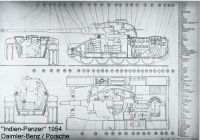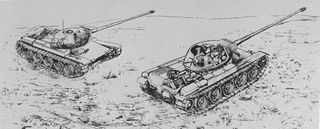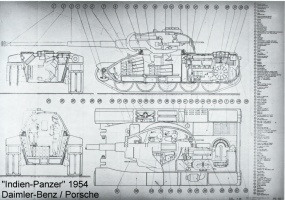Indien-Panzer
Indien_Panzer (Stock)
| 2420000 Preis |
| 1300 SPRobustheit |
| 39.87 / 43 Gewicht |
- Kommandant
- Funker
- Richtschütze
- Fahrer
- Ladeschütze
| 90/90/45Wannenpanzerung(Front/Seiten/Heck mm) |
| 90/90/45Turmpanzerung(Front/Seiten/Heck mm) |
| 500 PSMotorleistung |
| 50 km/hHöchstgeschwindigkeit vorwärts/rückwärts |
| 34 °/sDrehen/Wenden |
| 220 damage |
| 145 mmMittlere Durchschlagskraft |
| 6.2 Dauer für vollständiges Nachladen |
| 36 °/sGeschützrichtgeschwindigkeit |
| 260 mSichtweite |
| 500 mFunkreichweite |



Turm
| Stufe | Turm | Turmpanzerung (Front/Seiten/Heck mm) | Geschützrichtgeschwindigkeit (°/s) | Sichtweite (m) | Erfahrung | Gewicht (t) |
|---|---|---|---|---|---|---|
| VIII | Indien-Panzer | 90/90/45 | 36 | 260 | 0 | 9200 |
| Stufe | Geschütz | Mittlere Durchschlagskraft (mm) | Feuergeschwindigkeit | Streuung auf 100 m | Zielerfassung | Erfahrung | Gewicht (t) | |
|---|---|---|---|---|---|---|---|---|
| VII | 8,8 cm Kw.K. 36 L/56 | 145/195/44 | 220/220/270 | 9.68 | 0.38 | 2.3 | 0 | 2050 |
| VIII | 8,8 cm Kw.K. 43 L/71 | 203/237/44 | 220/220/270 | 8.59 | 0.34 | 2.9 | 16500 | 2562 |
| VIII | 9 cm Bordkanone | 212/259/45 | 225/225/270 | 8.96 | 0.34 | 2.9 | 18300 | 1650 |

Motor
| Stufe | Motor | Motorleistung (PS) | Brandwahrscheinlichkeit bei Treffer | Erfahrung | Gewicht (t) |
|---|---|---|---|---|---|
| VIII | MTU MB 837 | 500 | 15 | 0 | 1500 |
| IX | MTU MB 837 A | 630 | 12 | 21000 | 1500 |

| Stufe | Fahrwerk | Maximalgewicht | Drehen/Wenden (°/s) | Erfahrung | Gewicht (t) |
|---|---|---|---|---|---|
| VII | B-PS 102 | 43 | 34 | 0 | 10000 |
| VIII | Indien-Panzer | 43 | 38 | 14000 | 10000 |

Funkgerät
| Stufe | Funkgerät | Funkreichweite (m) | Erfahrung | Gewicht (t) |
|---|---|---|---|---|
| III | FuG5_GER | 500 | 0 | 50 |
Compatible Equipment
Compatible Consumables
Player Opinion
Pros and Cons
Pros:
- Excellent gun depression
- Narrow turret is hard to hit, especially if hull-down and rocking side-to-side
- Great AP shell penetration
- Above-average maneuverability
- Good rate of fire and DPM
Cons:
- Bad aim time and dispersion
- Sub-par acceleration
- Tempting yet unreliable turret armor profile
Performance
The Indien Panzer can be a difficult tank to master. It has few true standout traits as well as few glaring deficiencies. It can easily be the medium tank version of the saying "jack of all trades, master of none." Drivers will likely succeed in this tank if they vary their play style frequently depending on the tier and makeup of the individual match. This inherent required flexibility is what makes the Indien difficult to master.
When top tier, the IP can take advantage of it's reasonable turret armor and good gun depression in hull down situations. Even still, the turret is not super strong. This is NOT a Pershing that can sit still hull down and pelt other tanks with round after round while incoming fire bounces harmlessly off the mantlet. The Indien's turret has a smaller mantlet but an interesting rounded shape. There are areas between the mantlet and sides which can be penetrated, though they're not exceedingly large. The solution is to peek over cover only briefly and snap shoot, or move quickly, bait a missed shot or bounced round, and THEN expose, aim and fire. This "dancing" tactic works best if the chosen ridge allows the driver to come left to right in the enemy's field of fire, wreaking havoc with auto aim and attempts to lead without.
When lower tier, the Indien's turret armor morphs to far less reliable. It's weak points become larger to higher penetration enemy rounds and even a mobile dancing hull down strategy is rarely effective. As such, in these games Indien drivers should seek to play more of a second line support role. Try and take positions just behind allies to make use of the good DPM. Heavy armor angling can work as well, though is difficult to pull off effectively.
The Indien will never see Tier X matches again as a result of the new Matchmaking.
Early Research
The stock gun is poor, but the 8,8 cm Kw.K. 43 L/71 is bearable. Researching the 9cm will vastly improve firepower, but mobility will be lacking. If choosing mobility first, tracks are likely a better upgrade before engine in terms of maneuverability.
Historical Info
The Indian panzer competed with the British design, which the Indians eventually choose. Interestingly the Vickers tank was built entirely from welded rolled steel plates. According to some sources this feature was seen as an advantage by the Indian army, who wanted the tank to be license built in the country. Cast armor requires special foundry facilities, which were not available in India at the time the Vickers tank was developed. The Porsche design, on the contrary, had cast turret and much of the hull, so to build it in India might have been considered not impossible but surely quite difficult and expensive.
The project was rejected in the drawing phase, and no prototypes were ever built. The Indians eventually went for the Vickers MBT whose prototype was completed in 1963 and the tank entered service in 1965. The first 90 vehicles were built by Vickers in the UK, while production continued at the Heavy Vehicles Factory in Avadi. A total of 2,200 units under the name Vijayanta were built until 1983 when the production was stopped.
Historical Gallery


